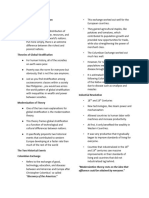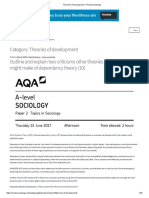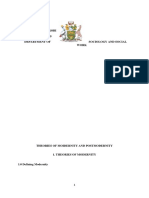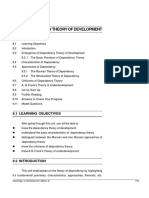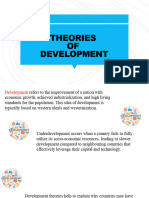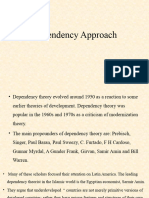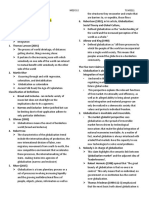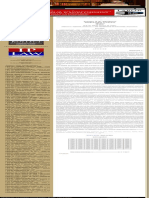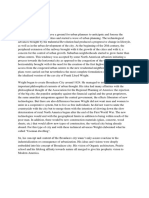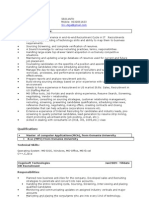Midterm Reviewer - The Contemporary World
Midterm Reviewer - The Contemporary World
Uploaded by
Maryknoll Nitura0 ratings0% found this document useful (0 votes)
48 views4 pagesThe document summarizes different theories of global stratification and poverty. It discusses theories such as modernization theory, dependency theory, and world systems theory to explain global economic inequality. It also outlines rationalist, culturalist, and structuralist theories that aim to explain the causes of poverty at the individual and country levels. Key factors discussed include colonialism, unequal global trade relationships, cultural values and mindsets, and external economic structures beyond individual control.
Original Description:
Original Title
Midterm%20Reviewer_The%20Contemporary%20World
Copyright
© © All Rights Reserved
Available Formats
DOCX, PDF, TXT or read online from Scribd
Share this document
Did you find this document useful?
Is this content inappropriate?
Report this DocumentThe document summarizes different theories of global stratification and poverty. It discusses theories such as modernization theory, dependency theory, and world systems theory to explain global economic inequality. It also outlines rationalist, culturalist, and structuralist theories that aim to explain the causes of poverty at the individual and country levels. Key factors discussed include colonialism, unequal global trade relationships, cultural values and mindsets, and external economic structures beyond individual control.
Copyright:
© All Rights Reserved
Available Formats
Download as DOCX, PDF, TXT or read online from Scribd
Download as docx, pdf, or txt
0 ratings0% found this document useful (0 votes)
48 views4 pagesMidterm Reviewer - The Contemporary World
Midterm Reviewer - The Contemporary World
Uploaded by
Maryknoll NituraThe document summarizes different theories of global stratification and poverty. It discusses theories such as modernization theory, dependency theory, and world systems theory to explain global economic inequality. It also outlines rationalist, culturalist, and structuralist theories that aim to explain the causes of poverty at the individual and country levels. Key factors discussed include colonialism, unequal global trade relationships, cultural values and mindsets, and external economic structures beyond individual control.
Copyright:
© All Rights Reserved
Available Formats
Download as DOCX, PDF, TXT or read online from Scribd
Download as docx, pdf, or txt
You are on page 1of 4
Midterm Reviewer: The Contemporary World
CHAPTER II: THE GLOBAL ECONOMY
Millenium Sustainable THEORIES OF GLOBAL STRATIFICATION
Development Goals Development Goals
(MDG) (SDG) A. Modernization theory
Time Frame 2000-2015 2015-2030 • Modernization theory argues that the tension between tradition
and technological change is the biggest barrier to growth.
Committed 189 193
Countries 2 historical events attributed to the rapid growth of Europe:
Number of Goals 8 17 1. Columbian Exchange: This refers to the spread of goods,
Target 21 (Developing 169 (Entire World, technology and diseases between the Americas and Europe
Countries, particularly both the rich and poor) after the so-called “discovery of the Americas”
the poorest)
2. Industrial Revolution (18th-19th century): This is when new
technologies, like steam power and mechanization, allowed
• According to the United Nations (as cited in Shangquan, 2000), “ countries to replace human labor with machines and increase
economic globalization refers to the increasing productivity.
interdependence of world economies as a result of the
growing scale of cross-border trade of commodities and services, Walt Rostow’s four stages of modernization
flow of international capital, and wide and rapid spread of 1. Traditional Stage
technologies.” 2. Take-Off Stage
3. Drive to Technological Maturity
Two types of economies associated with economic globalization: 4. High Mass Consumption
1. PROTECTIONISM- a policy of systematic government Criticisms:
intervention in foreign trade with the objective of encouraging domestic • It is just a new name for the idea that capitalism is the only way
production. for a country to develop.
Forms of protectionism • It sweeps a lot of historical factors under the rug.
1. Quota • It is seen as “blaming the victim.”
2. Tariffs
3. Embargo B. DEPENDENCY THEORY
4. Subsidy • Initially developed by Hans Singer and Raul Prebisch in the
1950s
2. LIBERALIZATION- based from the neoliberal principle • Rather than focusing on what poor countries are doing wrong,
of Keynes, that is, a country should encourage free flow of goods dependency theory focuses on how poor countries have been
and services. wronged by richer nations.
• This theory argues that global stratification starts with is not having access to school and not knowing how to read. Poverty is
colonialism. not having a job, is fear for the future, living one day at a
time…….Poverty is powerlessness, lack of representation and freedom.”
Basis: Atlantic Slave Trade
• European landowners needed a large supply of workers on In simpler definition, poverty means not having the opportunities and
American plantations; thus, to meet their growing labor needs, choices which open up a better future.
Europeans enslaved millions of Africans in forced labor in the
Americas. Types of Poverty
1. Absolute Poverty
C. WORLD SYSTEMS THEORY 2. Relative Poverty
• Developed by Immanuel Wallerstein
• Argues that the world system is established on a 3-level THEORETICAL EXPLANATIONS OF POVERTY
hierarchy. Under this system, some countries benefit while
others are being taken advantage of. A. RATIONALIST THEORY OF POVERTY: Poverty is the result of
• IN GENERAL, the peripheral serve the interests of the wealthier decisions made by people who, while acting in an individually
countries and end up having little to no resources to put forward intentional and rational manner, generate socially irrational
their own development. outcomes at a collective level.
• The development of the peripheral countries; therefore, is
stagnant because of the exploitative nature of the core nations. B. CULTURALIST THEORY OF POVERTY: Countries are poor because
they lack the appropriate values and practices that make sustained
Classification of countries: economic development possible.
1. Core
2. Semi-periphery According to Oscar Lewis, poor people around the world are
3. Periphery characterized by the following cultures of poverty:
Immediate Gratification, when people want pleasures now and
do not think for the future
Fatalism, when people think, ‘what will be’ and assume they
cannot escape from a bad situation
Poor people do not have a good work ethic and expect bad jobs
Segregate themselves from the mainstream society
Modern Cultural Values include the following:
1. Commitment to science
2. Universalism
CHAPTER III: WHY ARE COUNTRIES POOR? 3. Independence
4. Educational achievement
The dictionary defines poverty as: “Not having the minimum income level
to get the necessities of life.” C. STRUCTURALIST THEORY OF POVERTY: Structuralists will point
out that individual actors have no choice, they will still be poor because
World Bank defines poverty as: “Poverty is hunger. Poverty is lack of
shelter. Poverty is being sick and not being able to see a doctor. Poverty
poor people are embedded in structures that are external and beyond
their control.
Examples:
1. Theory of Geographic Luck by Jared Diamond
2. World Systems Theory by Immanuel Wallerstein
You might also like
- Contemporary World ReviewerDocument7 pagesContemporary World ReviewerAnzelle Armonio100% (3)
- Bachelor of Science in Civil EngineeringDocument2 pagesBachelor of Science in Civil EngineeringMaryknoll NituraNoch keine Bewertungen
- Airbus Aircraft PerformanceDocument216 pagesAirbus Aircraft Performancecaptvinicius100% (22)
- Ernest Mandel, Beyond Perestroika: The Future of Gorbachev's USSR, London: Verso, 1989Document236 pagesErnest Mandel, Beyond Perestroika: The Future of Gorbachev's USSR, London: Verso, 1989danielgaidNoch keine Bewertungen
- Zumba® - Ditch The Workout, Join The Party! The Zumba Weight Loss ProgramDocument272 pagesZumba® - Ditch The Workout, Join The Party! The Zumba Weight Loss ProgramPooja Jugdar Deshmukh100% (1)
- PDF PDFDocument11 pagesPDF PDFshanika jayaweeraNoch keine Bewertungen
- Montives TheoriesofDevelopment LKSDTTH111230Document3 pagesMontives TheoriesofDevelopment LKSDTTH111230Jjae Camus MontivesNoch keine Bewertungen
- 6 PPT - ANT 101 - World System and ColonialismDocument28 pages6 PPT - ANT 101 - World System and ColonialismMaliha Naim Nida (143011191)Noch keine Bewertungen
- Theories of Global StratificationDocument5 pagesTheories of Global StratificationdevilladaphneleighdNoch keine Bewertungen
- TCW Midterm ModulesDocument7 pagesTCW Midterm ModulesYsduh GamingNoch keine Bewertungen
- Theories of Development - ReviseSociologyDocument32 pagesTheories of Development - ReviseSociologyahsanNoch keine Bewertungen
- Contemporary-world-reviewer-chap-1-3.PDF (Source - StuDocu, Downloaded by - KC)Document8 pagesContemporary-world-reviewer-chap-1-3.PDF (Source - StuDocu, Downloaded by - KC)2022-201417Noch keine Bewertungen
- Lec-5-Gender Studies Gender and DevelopmentDocument9 pagesLec-5-Gender Studies Gender and Developmentfaisal waleedNoch keine Bewertungen
- Challenges To Globalism - Change and DevelopmentDocument16 pagesChallenges To Globalism - Change and DevelopmentDon Zian EncarnacionNoch keine Bewertungen
- HandoutsDocument2 pagesHandoutsJihad U. ShariefNoch keine Bewertungen
- GE 03 ReviewerDocument6 pagesGE 03 ReviewerMark James Dela CruzNoch keine Bewertungen
- THE Contemporary World GE 3 Module Final - UNIT I. INTRODUCTION TO GLOBALIZATION Overview This Unit - StudocuDocument1 pageTHE Contemporary World GE 3 Module Final - UNIT I. INTRODUCTION TO GLOBALIZATION Overview This Unit - StudocuZyribelle Anne JAPSONNoch keine Bewertungen
- Goods and Services People: - Trade - Skills/Profession - Immegration/Culture/ - Labor - Money - InvestmentDocument13 pagesGoods and Services People: - Trade - Skills/Profession - Immegration/Culture/ - Labor - Money - InvestmentcassandraNoch keine Bewertungen
- Theories of GlobalizationDocument37 pagesTheories of GlobalizationAbtaji Princess AndreaNoch keine Bewertungen
- Modernisation - Theory ppt-1Document17 pagesModernisation - Theory ppt-1Ibrahim Mohamed Ibrahim100% (1)
- Defining GlobalizationDocument79 pagesDefining GlobalizationDan GregoriousNoch keine Bewertungen
- Theories of ColonialismDocument3 pagesTheories of ColonialismTriveni PrakashNoch keine Bewertungen
- Globalization PDFDocument61 pagesGlobalization PDFNixon PeraltaNoch keine Bewertungen
- Contemp WorldDocument5 pagesContemp Worldqweyo yhuNoch keine Bewertungen
- Chapter 2 Lesson 3Document29 pagesChapter 2 Lesson 3hi qtieeNoch keine Bewertungen
- TCW - ReviewerDocument6 pagesTCW - ReviewerMaureen PortacioNoch keine Bewertungen
- Q2 Module 5Document5 pagesQ2 Module 5Leo BasNoch keine Bewertungen
- Marx and DependencyDocument22 pagesMarx and DependencyNdabenhle FlodyNoch keine Bewertungen
- Contemp RevDocument9 pagesContemp RevNubskie 314Noch keine Bewertungen
- Chapter 1 Introduction To Globalization 1Document54 pagesChapter 1 Introduction To Globalization 1Dave Paj'sNoch keine Bewertungen
- Capitalist Corruption Leading To Global Socio-Economic CollapseDocument23 pagesCapitalist Corruption Leading To Global Socio-Economic CollapseSci SciNoch keine Bewertungen
- Society The Basics Canadian 6Th Edition Macionis Solutions Manual Full Chapter PDFDocument32 pagesSociety The Basics Canadian 6Th Edition Macionis Solutions Manual Full Chapter PDFSallyRobertscmnq100% (14)
- Economics and The Space of DevelopmentDocument16 pagesEconomics and The Space of DevelopmentsohaibbodlaNoch keine Bewertungen
- 4 Theorizing GlobalizationDocument22 pages4 Theorizing GlobalizationRechelyn ModanzaNoch keine Bewertungen
- Chapter 2 Lesson 2 THEORIESDocument18 pagesChapter 2 Lesson 2 THEORIESKyla Lizette MorilloNoch keine Bewertungen
- (Notes) GECCON M1-3Document2 pages(Notes) GECCON M1-3Alexis PabonNoch keine Bewertungen
- TCW Midterms COMPLETEDocument15 pagesTCW Midterms COMPLETEKriscel LanzuelaNoch keine Bewertungen
- Teori Pembangunan KlasikDocument94 pagesTeori Pembangunan Klasikselvi slvNoch keine Bewertungen
- Global Stratification 072134Document20 pagesGlobal Stratification 072134Nash AkanulNoch keine Bewertungen
- Oup4 MarxismMatrixDocument2 pagesOup4 MarxismMatrixERICAH VILLACARLOSNoch keine Bewertungen
- University of Nairobi Faculty of Arts Department of Sociology and Social WorkDocument16 pagesUniversity of Nairobi Faculty of Arts Department of Sociology and Social WorkHassan MagdiNoch keine Bewertungen
- Dualistic TheoriesDocument5 pagesDualistic Theoriessuji8161Noch keine Bewertungen
- Globalization: Dr. Manny DyDocument36 pagesGlobalization: Dr. Manny DySlaghard Aneraj100% (1)
- The Contemporary World Pointer AimeeDocument3 pagesThe Contemporary World Pointer Aimeebobadillamarie156Noch keine Bewertungen
- Lecture 3 Global StratificationDocument22 pagesLecture 3 Global StratificationNessy Nicholle SatruionNoch keine Bewertungen
- UCSP11 q2 W4 Social-Inequalities Pascua v2Document20 pagesUCSP11 q2 W4 Social-Inequalities Pascua v2plswork72Noch keine Bewertungen
- Development AlternativesDocument147 pagesDevelopment AlternativesMonika Nathawat na18b027Noch keine Bewertungen
- Unit 9: Dependency Theory of DevelopmentDocument14 pagesUnit 9: Dependency Theory of DevelopmentsuryajayanthNoch keine Bewertungen
- Chapter One: Contemporary World and Globalization Advantages of GlobalizationDocument2 pagesChapter One: Contemporary World and Globalization Advantages of GlobalizationYari Hillary Herbias TamarayNoch keine Bewertungen
- Socecon ReviewerDocument6 pagesSocecon ReviewerSonnet CidNoch keine Bewertungen
- SOC SCI 103 ContemporaryDocument63 pagesSOC SCI 103 Contemporarykyleeawakan100% (1)
- SS02 - Chapter 2Document6 pagesSS02 - Chapter 2jessabongbongNoch keine Bewertungen
- PIED Final PresentationDocument22 pagesPIED Final PresentationSamuel YazoNoch keine Bewertungen
- AsdfghjkmnDocument15 pagesAsdfghjkmnLaila GoldeNoch keine Bewertungen
- Development TheoriesDocument34 pagesDevelopment TheoriesDwayne ReidNoch keine Bewertungen
- 1 GE 3 Introduction To GlobalizationDocument8 pages1 GE 3 Introduction To GlobalizationJi JiNoch keine Bewertungen
- Dependency ApproachDocument24 pagesDependency Approachlumos maximaNoch keine Bewertungen
- The Contemporary World Notes PDFDocument7 pagesThe Contemporary World Notes PDFHyacinth BernardoNoch keine Bewertungen
- CONTEMPDocument2 pagesCONTEMPShona AquinoNoch keine Bewertungen
- TCW Reviewer PrelimsDocument7 pagesTCW Reviewer PrelimsManong GuardNoch keine Bewertungen
- Review-Materials-SOCSCI 2Document5 pagesReview-Materials-SOCSCI 2bgdp8hzbzyNoch keine Bewertungen
- TCW ReviewerDocument5 pagesTCW Reviewermenchie navarroNoch keine Bewertungen
- The Contemporary WorldDocument5 pagesThe Contemporary WorldKarla Sofia AllocodNoch keine Bewertungen
- Stratification Is A System or Formation of Layers, Classes, or CategoriesDocument21 pagesStratification Is A System or Formation of Layers, Classes, or CategoriesPaylip MerryNoch keine Bewertungen
- Empire, Global Coloniality and African SubjectivityFrom EverandEmpire, Global Coloniality and African SubjectivityNoch keine Bewertungen
- Elements of MusicDocument28 pagesElements of MusicMaryknoll NituraNoch keine Bewertungen
- MODULE 1 Nexus ApproachDocument24 pagesMODULE 1 Nexus ApproachMaryknoll NituraNoch keine Bewertungen
- Bicol State College of Applied Sciences and Technology: Republic of The Philippines City of NagaDocument15 pagesBicol State College of Applied Sciences and Technology: Republic of The Philippines City of NagaMaryknoll NituraNoch keine Bewertungen
- The Contemporary World Module No. 1Document5 pagesThe Contemporary World Module No. 1Maryknoll NituraNoch keine Bewertungen
- The Contemporary World Module No. 2Document6 pagesThe Contemporary World Module No. 2Maryknoll NituraNoch keine Bewertungen
- People vs. Alban, G.R. No. 112279, July 03, 1995Document2 pagesPeople vs. Alban, G.R. No. 112279, July 03, 1995sbbNoch keine Bewertungen
- LLB 12+5 - 2 - PDFDocument137 pagesLLB 12+5 - 2 - PDFNitesh JaisinghaniNoch keine Bewertungen
- Eir November2017Document941 pagesEir November2017AbhishekNoch keine Bewertungen
- A.M. No. 10-7-17-SC October 15, 2010 in The Matter of The Charges of Plagiarism, Etc., Against Associate Justice Mariano C. Del CastilloDocument13 pagesA.M. No. 10-7-17-SC October 15, 2010 in The Matter of The Charges of Plagiarism, Etc., Against Associate Justice Mariano C. Del CastilloKhaylilNoch keine Bewertungen
- (AMALEAKS - BLOGSPOT.COM) ICT-2300 Week 1-10 Grade 12Document12 pages(AMALEAKS - BLOGSPOT.COM) ICT-2300 Week 1-10 Grade 12mc kevin badillaNoch keine Bewertungen
- The Complication of Considering Gadgets As Part of Learning Tool of StudentsDocument41 pagesThe Complication of Considering Gadgets As Part of Learning Tool of StudentsDkaye GorospeNoch keine Bewertungen
- Marketing Plan For A New ProductDocument14 pagesMarketing Plan For A New ProductAhmer NaveerNoch keine Bewertungen
- CattronControl Excalibur by Cattron - Industrial Wireless Remote Control PDFDocument2 pagesCattronControl Excalibur by Cattron - Industrial Wireless Remote Control PDFJose Gabriel Aguirre AndradeNoch keine Bewertungen
- Sanidad Vs ComelecDocument1 pageSanidad Vs ComelecLarry Fritz SignabonNoch keine Bewertungen
- Uncertainity Reduction Theory (Charles Berger) - SimplifiedDocument2 pagesUncertainity Reduction Theory (Charles Berger) - SimplifiedRajesh Cheemalakonda100% (2)
- Mariner Role in Collecting EvidenceDocument42 pagesMariner Role in Collecting EvidenceDilip de SilvaNoch keine Bewertungen
- Architecture and Social Structure PDFDocument2 pagesArchitecture and Social Structure PDFAr Ambuj SharmaNoch keine Bewertungen
- Network ModelsDocument12 pagesNetwork ModelsAshikNoch keine Bewertungen
- Project Proposal: Situation/Problem/OpportunityDocument3 pagesProject Proposal: Situation/Problem/OpportunityShailani HossainNoch keine Bewertungen
- Write An Essay of About 350 Words To Present Your Opinion On This Issue. Give Reasons and Specific Examples To Support Your PositionDocument2 pagesWrite An Essay of About 350 Words To Present Your Opinion On This Issue. Give Reasons and Specific Examples To Support Your PositionCẩm TúNoch keine Bewertungen
- Proclamation and Emergency Management Act (Barbados 2021)Document22 pagesProclamation and Emergency Management Act (Barbados 2021)Hanson AboagyeNoch keine Bewertungen
- OSHA Slide Chapter 1Document56 pagesOSHA Slide Chapter 1Jia Yee Ten100% (2)
- Broadacre CityDocument8 pagesBroadacre CitySuresh Twanabasu A PositiveNoch keine Bewertungen
- Ch12 Project AuditingDocument41 pagesCh12 Project AuditingM Ilham Ghifari100% (2)
- Sreekanth Resume (Recruiter)Document2 pagesSreekanth Resume (Recruiter)Raj KiranNoch keine Bewertungen
- Micro Project Formats - WPDDocument4 pagesMicro Project Formats - WPDshubham100% (1)
- Alternative Dispute Resolution in The Philippines:: W of The F T Re or The Ro Less TR ?Document4 pagesAlternative Dispute Resolution in The Philippines:: W of The F T Re or The Ro Less TR ?John Mark ParacadNoch keine Bewertungen
- ALFI Vs Hon. Janette GarinDocument12 pagesALFI Vs Hon. Janette GarinJulieNoch keine Bewertungen
- Conflict Zones A Training Model For InterpretersDocument19 pagesConflict Zones A Training Model For InterpretersToma BabaninaNoch keine Bewertungen
- Tabletop Wargaming Should Be Used in SchoolsDocument7 pagesTabletop Wargaming Should Be Used in SchoolsAzka IhsanNoch keine Bewertungen
- BIM and Sustainability in Terms of Philippine StandardsDocument6 pagesBIM and Sustainability in Terms of Philippine Standardsraifel100% (1)








